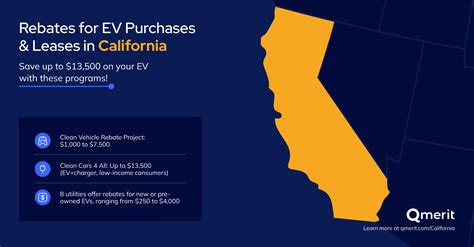Introduction
The shift towards electric vehicles (EVs) has gained significant momentum in California, thanks in part to various incentives aimed at making the transition more affordable. For environmentally conscious consumers and those looking to save money in the long term, California’s electric car rebates are an excellent way to maximize savings while contributing to a healthier planet. In this guide, we will explore the different types of rebates available, eligibility criteria, and tips to make the most of these incentives.
Understanding Electric Car Rebates
Electric car rebates are incentives provided by the state of California to encourage consumers to purchase or lease electric vehicles. The primary aim is to reduce greenhouse gas emissions and promote cleaner air. California offers several programs, including federal tax credits and state-specific rebates, which can significantly reduce the overall cost of an electric vehicle.
Types of Rebates Available
1. Clean Vehicle Rebate Project (CVRP)
The CVRP offers rebates to eligible buyers of new, qualified EVs and plug-in hybrid electric vehicles (PHEVs). The rebate amounts can range from $1,000 to $7,000, depending on the vehicle type and the buyer’s income level. Low- and moderate-income residents may qualify for a higher rebate amount.
2. Federal Tax Credit
The federal government offers a tax credit of up to $7,500 for electric vehicle buyers. However, it’s important to note that this credit phases out once a car manufacturer sells 200,000 electric vehicles. Therefore, while many popular brands qualify, some may no longer offer the full credit depending on their sales volumes.
3. Local Utility Company Incentives
Many utility companies in California provide additional rebates or incentives for electric vehicle owners. These can include rebates for home charging station installations, lower electricity rates for EV charging, and even cash back on EV purchases. It’s advisable to check with your local utility provider to learn about specific programs available in your area.
Eligibility Criteria
To maximize your savings with electric car rebates, it’s essential to understand the eligibility criteria. Here are the main factors that will influence your eligibility:
- Residency: Generally, applicants must be California residents.
- Vehicle Type: The vehicle must be a new, eligible electric vehicle or plug-in hybrid.
- Income Level: Some rebates, like the CVRP, have income-based eligibility, offering more significant incentives for low- and moderate-income households.
- Purchase or Lease: Many programs apply to both purchases and leases, but the rebate amounts may differ.
How to Apply for Rebates
Applying for electric car rebates in California is a straightforward process, but it’s crucial to follow the steps carefully to ensure you receive the benefits:
- Research Available Rebates: Check both state and local utility company websites for available rebates.
- Purchase or Lease an Eligible Vehicle: Ensure the vehicle you select qualifies for the rebates.
- Gather Required Documentation: This may include proof of residency, vehicle purchase agreements, and income documentation.
- Submit Your Application: Follow the specific guidelines for each rebate program. Most applications can be submitted online.
- Monitor Your Application: Keep track of your application status and respond to any requests for additional information quickly.
Additional Tips for Maximizing Savings
In addition to leveraging electric car rebates, consider these additional tips to maximize your overall savings:
- Evaluate Total Cost of Ownership: Consider factors such as fuel savings, maintenance costs, and potential tax benefits over the vehicle’s lifespan.
- Look for Additional Incentives: Keep an eye out for manufacturer incentives, such as cash rebates or discounted leases.
- Calculate Charging Costs: When calculating savings, include lower electricity costs compared to gasoline prices.
Conclusion
California’s electric car rebates offer a valuable opportunity to reduce the financial burden of transitioning to an electric vehicle. By understanding the types of available rebates, eligibility criteria, and the application process, consumers can maximize their savings while making a positive impact on the environment. Whether you’re a first-time buyer or an experienced EV owner, taking advantage of these incentives can help you enjoy the benefits of eco-friendly driving without breaking the bank.
FAQs
1. What is the maximum rebate amount available for electric vehicles in California?
The maximum rebate amount can vary. Under the Clean Vehicle Rebate Project (CVRP), rebates can range from $1,000 to $7,000 based on vehicle type and income level.
2. How do I know if my vehicle is eligible for the rebates?
Eligibility can be verified by checking the California Air Resources Board (CARB) website, which provides a list of eligible vehicles for various rebate programs.
3. Can I combine different rebates and incentives?
Yes, often you can combine state and federal rebates, as well as local utility incentives, to maximize your savings when purchasing an electric vehicle.
4. Is the federal tax credit refundable?
No, the federal tax credit is not refundable. It can reduce your tax liability, but it will not result in a cash refund if your tax liability is less than the credit amount.
5. How long does it take to receive the rebate after applying?
Processing times can vary, but typically you can expect to receive your rebate within 6-8 weeks after your application is approved.
Download Electric Cars Rebates California
